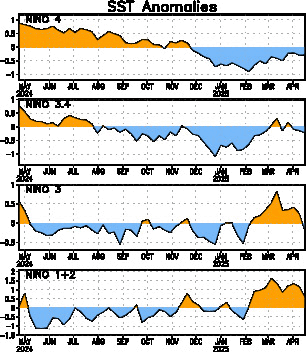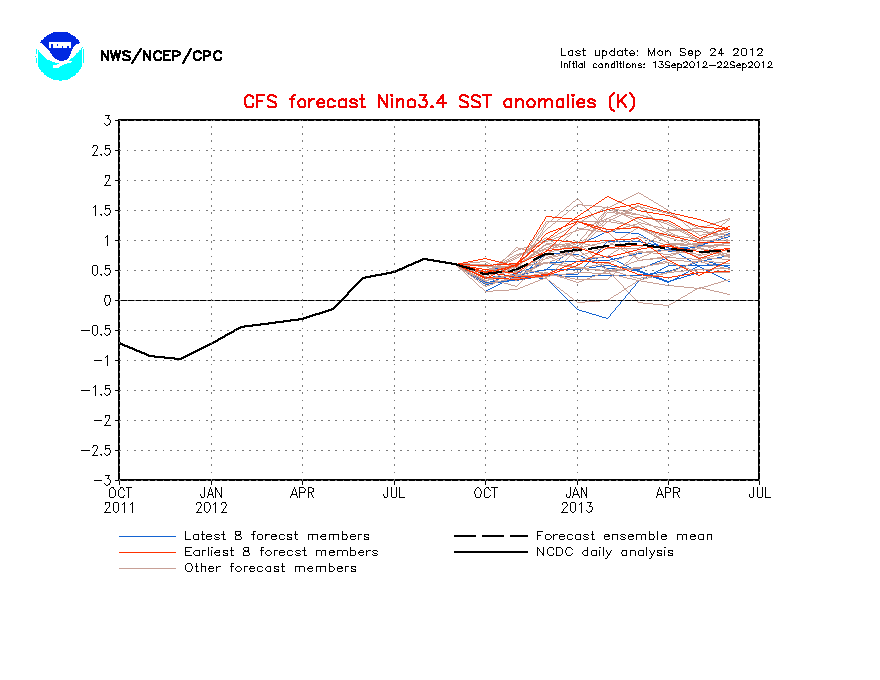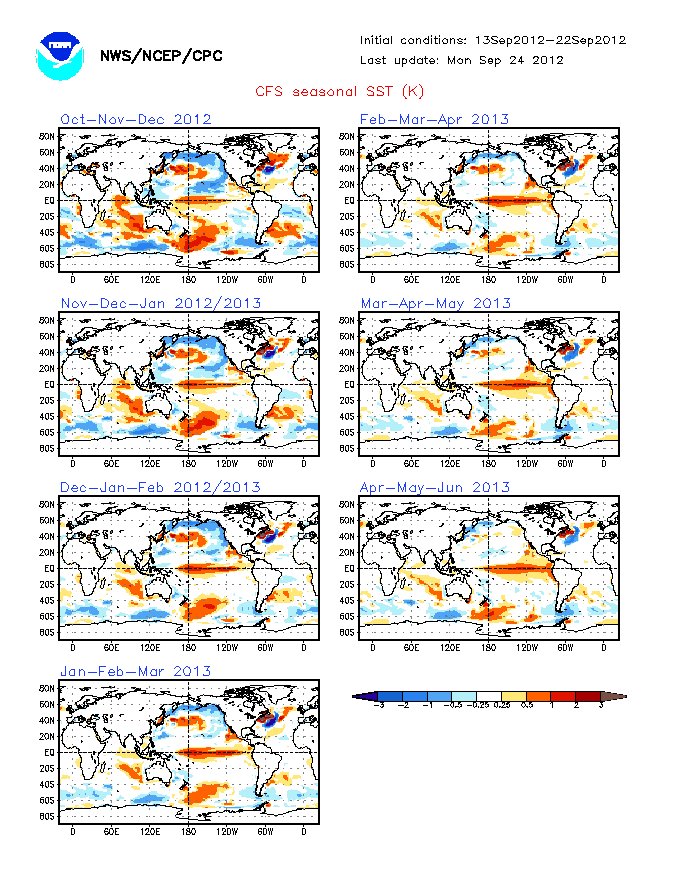Current Conditions
As of mid-February 2010, SSTs are well above-average throughout the central and eastern equatorial Pacific, indicative of moderate El Niño conditions. Between mid-June and early October, SSTs in the east-central tropical Pacific were at levels indicative of weak El Niño conditions. Starting in October, intermittently strong westerly wind anomalies in the western Pacific, extending into the central Pacific, substantially increased the magnitude of the warm SST anomalies. The traditional Southern Oscillation Index (SOI) became negative during October, and has remained negative since then. The equatorial SOI also became negative in October, but returned to near-average during November and December, becoming strongly negative only in January. Positive convection anomalies were observed intermittently near and just west of the dateline between June and September, and became somewhat stronger and more persistent since October. During late January and so far in February, positive convection anomalies became stronger and have assumed a key position just east of the dateline so as to most efficiently influence the zonal and meridional circulation patterns in the manner observed during previous moderate to strong El Nino episodes. Equatorial Pacific oceanic heat content had been above-average since early in the year, and became stronger after October. During January and February the heat content has somewhat decreased, but has nonetheless remained well above average. The SST anomalies are likely to stay at least moderately positive during the coming 1 to 2 months, due to the supply of accumulated anomalous sub-surface heat and the recent episode of strong westerly wind anomalies that are acting to slow depletion of sub-surface heat, and increasing it near and immediately east of the dateline.
For January 2009, the SST anomaly in the NINO3.4 region was 1.59 C, sufficient to be classified as moderate(+) El Niño conditions for this time of year. For the Nov-Dec-Jan season the anomaly was 1.69 degrees C. Currently the IRI's definition of El Niño conditions rests on an index of SST anomalies, averaged over the NINO3.4 region (5S-5N; 170W-120W), exceeding the warmest 25%-ile of the historical distribution, and similarly for La Niña relative to the 25%-ile coldest conditions in the historical distribution. The NINO3.4 anomaly necessary to qualify as La Niña or El Niño conditions for the Feb-Mar-Apr and the Mar-Apr-May seasons are approximately (-0.45C, 0.40) and (-0.40, 0.40), respectively.
Expected Conditions
The most recent weekly SST anomaly in the NINO3.4 region is 1.2 C, indicating moderate El Niño conditions in the tropical Pacific, down from the 1.59 C level observed in January. What is the outlook for the ENSO status going forward? The intermittent episodes of strengthened westerly wind anomalies along the equator in the western Pacific lasting several weeks at a time since late September provided substantial positive depth anomalies to the central and eastern thermocline. Beginning in October, the spatial pattern of SST anomalies, and of the subsurface temperature anomalies, become more structured and reminiscent of El Niño events. However, the extent to which this pattern of SST anomalies has induced a strong, multi-month atmospheric response leading to air-sea couping of the type observed in strong El Niño events, had not been great until early February. At that time, strongly positive convection anomalies finally assumed the critical location near and just east of the dateline. The behavior of the atmosphere has therefore recently begun acting as expected during moderate to strong El Nino events with air-sea coupling, despite that the NINO3.4 SST anomalies have somewhat decreased from their peak levels of between 1.5 and 2 C anomalies observed from November to January. Feedback to the ocean from this recent atmospheric behavior may temporarily slow further decreases in the SST anomaly during late February and early March.
February is the time of year when existing ENSO events are often in their beginning waning phase, and typically persist for one to three subsequent months while weakening. For this event, it seems most likely that El Niño conditions will persist at least through March 2010, and, given the still moderately strong subsurface anomalies and their maintenance due to recently strong westerly wind anomalies, may endure through April or even early May. A premature dissipation, such as that observed in early 2007, is not being observed for this event.
Presently, the models and observations taken together indicate probabilities of about 93% for maintaining El Niño conditions and about 6% for dissipation to ENSO-neutral conditions for the Feb-Mar-Apr season in progress. Going forward, probabilities for El Niño stay at or above 80% through Mar-Apr-May, after which they decrease to approximately 55-60% by Apr-May-Jun, falling to climatological probabilities of 25% by Jul-Aug-Sep. Probabilities for La Niña conditions are predicted to be negligible for the next several months, not exceeding 10% until May-Jun-Jul.
The above assessment was made in part on the basis of an examination of the current forecasts of ENSO prediction models as well as the observed conditions. For purposes of this discussion, El Niño SST conditions are defined as SSTs in the NINO3.4 region being in the warmest 25% of their climatological distribution for the 3-month period in question over the 1950-present timeframe. The corresponding cutoff in terms of degrees C of SST anomaly varies seasonally, being close to 0.40 degrees C in boreal late-spring to early-summer season and as high as 0.75 degrees C in late boreal autumn. La Niña conditions are defined as NINO3.4 region SSTs being in the coolest 25% of the climatological distribution. Neutral conditions occupy the remaining 50% of the distribution. These definitions were developed such that the most commonly accepted El Niño and La Niña episodes are reproduced.
The models are in general agreement in their ENSO forecasts through just the first portion of the 10-month forecast period, but show marked differences following northern spring. The statistical and dynamical models agree in predicting weakening El Niño conditions during the next 1 to 3 months, through early northern summer. However, the details of the timing and the rate of dissipation differ among models, and there is great disagreement in the outlook for the coming ENSO cycle from northern summer onward, with some models predicting neutral ENSO, some predicting La Nina, and some a second year of El Nino. For the current Feb-Mar-Apr season, 100% of the models are predicting El Niño conditions; none predict ENSO-neutral conditions. At lead times of 4 or more months into the future, statistical and dynamical models that incorporate information about the ocean's observed sub-surface thermal structure generally exhibit higher predictive skill than those that do not. Among models that do use sub-surface temperature information, 5 of 14 (36%) indicate El Niño conditions for the Jun-Jul-Aug season, 8 of 14 (57%) predict ENSO-neutral SSTs, and 1 of 14 (7%) predict La Niña conditions. (Note 1). Caution is advised in interpreting the distribution of model forecasts as the actual probabilities. At longer leads, the skill of the models degrades, and skill uncertainty must be convolved with the uncertainties from initial conditions and differing model physics, leading to more climatological probabilities in the long-lead ENSO Outlook than might be suggested by the suite of models. Furthermore, the expected skill of one model versus another has not been established using uniform validation procedures, which may cause a difference in the true probability distribution from that taken verbatim from the raw model predictions.
An alternative way to assess the probabilities of the three possible ENSO conditions is to use the mean of the forecasts of all models, and to construct a standard error function centered on that mean. The standard error would be Gaussian in shape, and would have its width determined by an estimate of overall expected model skill for the season of the year and the lead time. Higher skill would result in a relatively narrower error distribution, while low skill would result in an error distribution with width approaching that of the historical observed distribution. This method shows probabilities for El Niño at about 100% and 92% for Feb-Mar-Apr and Mar-Apr-May, respectively, declining to 36% by Jun-Jul-Aug and 31% by Jul-Aug-Sep. The same cautions mentioned above for the distribution of model forecasts apply to this alternative method of inferring probabilities, due to differing model biases and skills. In particular, this approach considers only the mean of the predictions, and not the range across the models, nor the ensemble range within individual models.

















